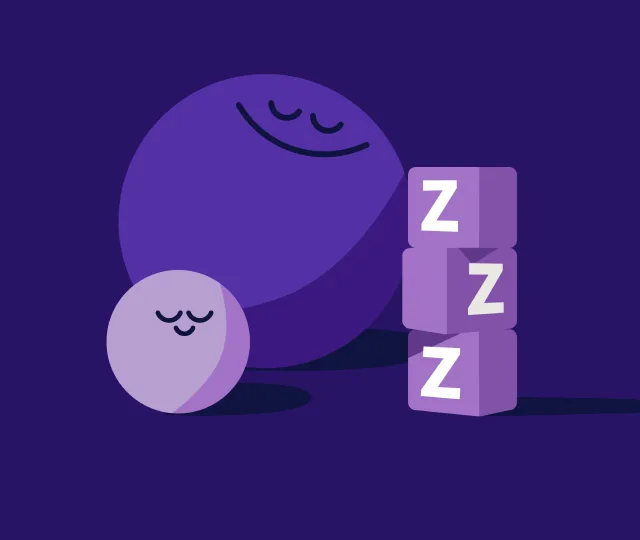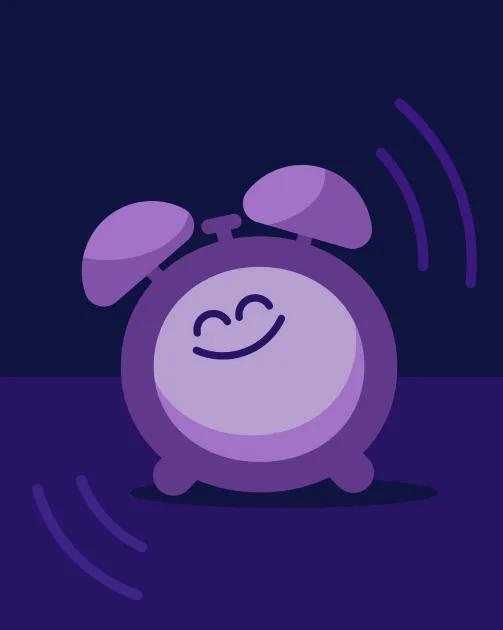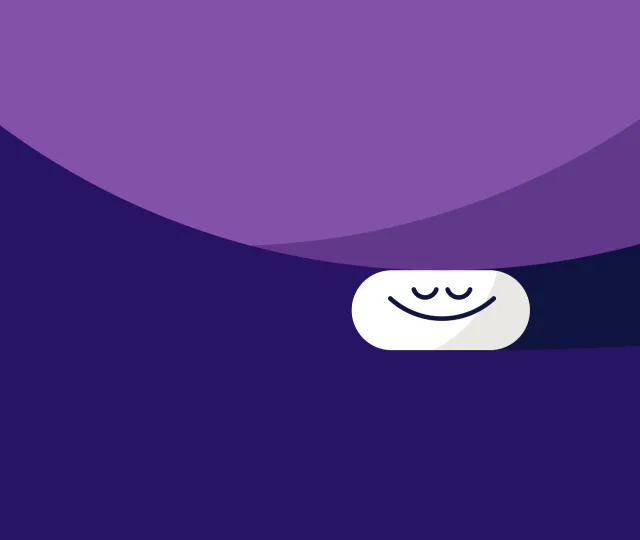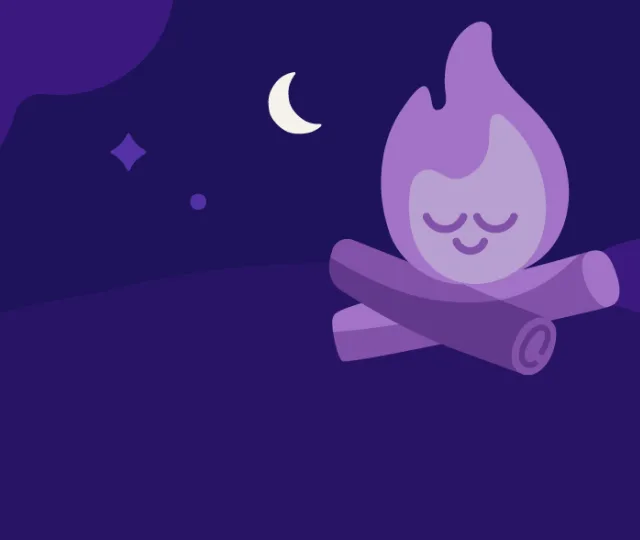Breathing exercises for better sleep
Researched and written by our mindfulness and meditation experts | Learn more
Feb 19, 2024
The stress of the day can send our minds into overdrive at night. We’re supposed to be resting, but our thoughts won’t let us fall asleep. Or they wake us up in the middle of the night. Or both.
While sleep hygiene is key to putting the mind to bed, there’s also another easy and effective way to let go of the day and relieve stress so we can get some rest: by controlling our breath using breathing exercises. When we take a purposefully slow inhale through the nose and a big, long exhale through the mouth, we signal to the mind and body that we’re safe, that it’s okay to calm down. From under the covers, we can slow down our thoughts, relax the body, and improve our chances of sleeping better, breath by breath.
Just like meditation, deep-breathing exercises can be practiced regularly as a part of a nighttime routine. They can also be used SOS-style to calm us down after waking up from loud noises or nightmares, or even as an alternative to grabbing our phones before bed. Anyway we do them, we’re creating conditions for a more restful sleep. So why not start tonight? Get tucked in and try the ones we’re sharing here.
DISCLAIMER: Please consult your doctor or medical provider to ensure breath work is suitable for you. Breathing exercises may present a risk of harm for people with certain medical and/or neurological conditions including epilepsy, cardiovascular issues, anxiety and PTSD, or people who are pregnant.
Key takeaways:
Deep-breathing exercises signal to the mind and body it’s okay to calm down and relax
Breathing exercises at bedtime and during the day can help us sleep better
Try 10 meditations for better sleep
Listen to 45 mins of sleep music

Listen to Sleep Music: Slumber - 45 min
What are breathing exercises for sleep?
Breathing exercises for sleep are just like other deep-breathing exercises we may have tried. We intentionally control how to breathe, taking slow, deep inhales and long exhales to experience a sense of relaxation. Not only does it increase airflow in the body, but it also activates our “rest and digest” system, which tells the body and mind to calm down — exactly what we want out of an exercise for better sleep.
Breathing exercises for sleep don’t demand much from us: only taking deep breaths and, in some cases, counting. They’re most often practiced at night when we’re in bed and we’re already tired (or hoping to be tired soon), so we don’t need to try too hard or think too much about getting it “right.” We can simply feel the body sinking into the bed, take a moment to enjoy that feeling, and start breathing.
Since these sleep exercises are so closely tied to the act of getting into bed — something we do every single night — they’re great for beginners to try. Why? Because tacking a new habit onto an existing routine makes it easier to do. Once our heads hit the pillow, taking those first 3 or 5 minutes to breathe deep doesn’t seem like another task to complete. It actually feels kind of luxurious. And maybe even a bit of self-care we begin to look forward to.
Now, breathing exercises won’t force us to sleep or guarantee good quality Zzz’s. We might finish a round of breath work in bed and still be wide awake. But, like meditation, deep breathing trains the mind to let go. We learn to focus less on our thoughts and more on our breath. The more we practice, the easier it will be to notice whatever pops up in our minds, let it go, and drift off.

How do I practice breathing exercises for sleep?
The first step to a regular practice is to get ourselves and our spaces ready for the night, just in case we fall asleep while we’re doing this breathing exercise. Once everything’s set and we’re in bed, it’s time to lay down flat on our backs with our necks as straight as possible so it’s nice and easy to breathe. While it’s best to lay without a pillow for this kind of sleep exercise, it’s even more important that we’re comfortable. So, we can use whatever support makes each of us feel good.
Next, settle in. The day has stopped and there’s nothing else to do. That alone must feel nice. Take a big breath in through the nose and out through the mouth. And let our breathing go back to normal. How’s the body feeling? Relaxed? Supported? Tense? Restless? No answer is good or bad in this moment. We’re simply identifying it so we can become more aware of how our breath works and makes us feel.
Still breathing normally, we can wind down a bit more by paying attention to each inhale and exhale. We might even want to gently place one hand on the stomach to feel our breath coming and going. After a few rounds of this, start the breathing exercises for sleep.
To feel even more benefits from this sleep exercise, we can start deep-breathing exercises for sleep way before our heads hit the pillow. Let’s go back to sleep hygiene for a bit.
When we practice good sleep hygiene, it means that we’re making choices throughout the day that support our circadian rhythm, aka our sleep cycle. Daytime workouts, limiting caffeine intake, and unplugging from devices an hour before bed are all examples of activities that set us up for better sleep at night. And now, research shows that slow, deep breathing combined with sleep hygiene and relaxation techniques like meditation may be “highly effective” in helping us fall asleep or back to sleep.
It’s especially useful to practice breathing exercises during a particularly stressful day. Research shows that deep breathing and other breath work techniques help us calm down during moments of stress. If we take the time to care for our minds in the moments we need to, it’s less likely to disturb us later that night.
If we decide that regular deep-breathing exercises are right for us, it’s important to note that we might still feel intense emotional or physical sensations during breath work. It’s common for tingling to occur in the hands or toes, tightening or other feelings of discomfort in the body, and even changes in body temperature.
If this happens, it’s nothing to fear. We can pause the breath work and return to normal breathing, bring our focus to an object in the room, stretch gently, or do something else that helps to settle the body. Remember: these breath work instructions are suggestions. We can always stop or do something else entirely.
What breathing exercises are good for sleep?
The best and most effective breathing exercises are the ones that work for each of us. Try the different practices and see what techniques and exercises fit. Then, we can use them as tools to help take control of our breath when we’re winding down for the night. In each of the techniques below, repeat for as long as it feels good.
Having a bad day? Try belly breathing.
Here’s a breathing exercise we can practice during the day to feel less stressed. We’re not breathing into our belly here, but the belly will puff out when we fill up our lungs. It might be helpful to place a hand on the stomach so we can feel how it rises and falls when we direct our breath there.
Slowly breathe in through the nose and feel the belly push out. Slowly exhale through the mouth and feel the belly draw inwards.
Can’t wind down? Try box breathing.
If we find ourselves unable to settle down before bed, this technique can help our mind focus on the present moment: being in bed with nothing to do.
For this breathing exercise, it might be helpful to imagine a box and its 4 equal sides. See it? This visualization will help us breathe and hold our breath for the same number of counts while we trace one corner to the next in our minds, all the way around the box.
Taking slow, deep breaths, inhale through the nose for 4, hold the breath for 4, exhale through the mouth for 4, and hold the breath for 4 before we inhale again.
Want to drift off? Try the 4-4-6 technique.
Here, we’re slowing the breathing with an extra-long exhale. Inhale through the nose for 4, hold the breath for 4, then exhale through the mouth for 6.
Count the breaths from 10 down to 1. Starting with an inhale, count 10, out 9, in 8, out 7. Continue with this kind of counting, counting backward, following the breath. Or just count without focusing on the breath.
Restless mind? Try counting backward.
Slowly and steadily, count down our breaths from any number. It could be 10 or 10,000. As we count, breathing in on 10, out on 9, in on 8, out on 7, and so on, remember to be easy on ourselves. There’s no need to get tripped up if we miscount or forget our place — this will probably happen and it’s perfectly normal and okay. Simply go back to the last number we can remember and continue. We’re not striving or straining, we’re staying with the smooth flow of the breath and the counting.
Restless body? Try a body scan.
A body scan is a meditation technique where we mentally scan our body from our toes up to our head at a steady, even pace. Kind of like how a copy machine scans a piece of paper. As we scan, we take long, deep breaths and focus on how each part feels.
Start with the toes. Inhale through the nose, exhale through the mouth, and notice if they feel relaxed or tense, comfortable or uncomfortable, energetic or tired. If we sense tension, don’t struggle. Instead, breathe into that part of the body again and notice if anything changes. If it does, great. If it doesn’t, that’s okay. We can move on.
Repeat this practice all the way up the body, going next to the feet, ankles, calves, shins, knees, thighs, and so on — taking about 20-30 seconds to focus on each body part.
Try 10 meditations for better sleep
Looking for more meditations for better sleep? A healthier, happier you is a few breaths away.
The Headspace app offers member courses and single meditations on breathing exercises, including:
Breathe meditation
Bring a sense of spaciousness into your day with a quick breathing exercise.Deep Breathing wind down
A super-simple breathing technique that activates the “rest and digest” part of the nervous system.Breathe With the Clouds mindful activity
Use this moment to check in with yourself by taking 5 deep breaths.Feeling Overwhelmed meditation
Give yourself a little space when you’re feeling overwhelmed.Switching Off wind down
A brief “switching off” visualization designed to relax the body and mind.Falling Back to Sleep wind down
Step out of the thinking mind with this exercise designed to lull you into a place of rest, allowing you to drift off back to sleep.Racing Mind meditation
A simple meditation created to soothe a racing mind and prepare you for sleep.Pause with 5 Calming Breaths mindful activity
Notice the sense of calm that arises as you follow the natural rhythm of your body and focus on 5 deep breaths.Mental Chatter meditation
Create space for the mind to gently come to rest with this nighttime meditation.Deep Breaths workout
A restorative class with extra attention on the breath to get you back to a more centered, calm state.
When we practice breathing exercises for sleep before bed and throughout the day, we give ourselves the best chance to wind down easily at night. Plus, we can feel confident knowing that we have a tool ready to help us fall back asleep the next time thoughts, noises, or bad dreams wake us up.
Breathing exercises - simple breathing techniques to relax your mind and body


Sleep made simple
- Find your perfect bedtime routine with hours of relaxing music, sounds, and stories to choose from
- Get more restful sleep with our Sleep Health course: exercises developed with leading sleep scientists
- Feel your best from morning to bedtime with access to hundreds of stress-relieving meditations
Annual - billed at $69.99 USD/yr
14 days free
$5.83 USD/month
Monthly
7 days free
$12.99 USD/month

Learn more about meditation

Stay in the loop
Be the first to get updates on our latest content, special offers, and new features.
By signing up, you’re agreeing to receive marketing emails from Headspace. You can unsubscribe at any time. For more details, check out our Privacy Policy.
- © 2025 Headspace Inc.
- Terms & conditions
- Privacy policy
- Consumer Health Data
- Your privacy choices
- CA Privacy Notice










